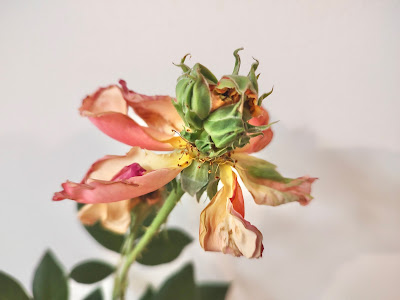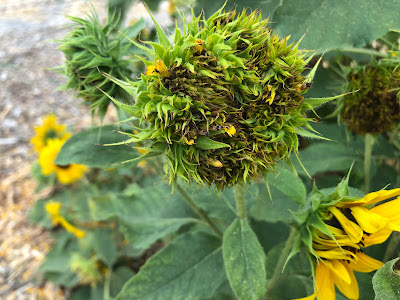
Hormone imbalance and heat fluctuations linked to deformed flowers

|
|
This About Face grandiflora rose is displaying
fasciation in its spent bloom. (Photo: Debbie
Arrington)
|
They look like something out of “Little Shop of Horrors”: Weirdly distorted buds that sprout out of the center of a spent rose. And this summer, more seem to be popping up on rose bushes throughout Sacramento – as well as other plants.
It’s another garden oddity likely tied to extreme fluctuations in temperature: Fasciation.
This phenomenon – strange, unexpected growth of terminal buds – is a genetic mutation of a plant’s growing tip. It’s believed to be triggered by a hormone imbalance that may be caused by outside factors such as roller-coaster temperatures or exposure to herbicides (such as Roundup).
I can’t help it; I’m fascinated by fasciation. In roses, it looks like a whole spray of monstrous buds is trying to wiggle out of the center of a bloom – often before the first flower has dropped its petals.
I have one hybrid tea – Perfect Moment – that always seems to display some fasciation in the heat of summer (and it did). But this August, I’m also seeing fasciation on bushes that never showed it before. That includes About Face, a very tall grandiflora; this week, several of its spent blooms sprouted the weird deformed buds.
The roses were not exposed to Roundup or other chemicals; it had to be the heat.
The good news: It’s not contagious. Snip off the weird flower and the plant will (fingers crossed) grow a “normal” bud.

|
|
Fasciation also can show up in sunflowers. This was a
bloom that exhibited some weird extra growth. (Photo: Kathy
Morrison)
|
In strawberries, fasciation creates giant double or triple berries. The cockscomb celosia – with flowers that look like rooster heads – are a result of fasciation.
Heirloom tomatoes – particularly those with ugly bottoms – are believed to be another case of fasciation as a desirable trait.
Fasciation also can produce flat, fused stems or tufts of fused growth, often referred to as “witches’ broom.” Besides heat and herbicides, fasciation may be caused by bacteria, in particular Rhodococcus fascians , say UC master gardeners.
For more on fasciation: http://ipm.ucanr.edu/PMG/GARDEN/FLOWERS/DISEASE/fasciation.html
Comments
0 comments have been posted.Sacramento Digs Gardening to your inbox.
Food in My Back Yard Series
April 29: What's (already) wrong with my tomato plants?
April 22: Should you stock up on fertilizer? (Yes!)
April 15: Grow culinary herbs in containers
April 8: When to plant summer vegetables
April 1: Don't be fooled by these garden myths
March 25: Fertilizer tips: How to 'feed' your vegetables for healthy growth
March 18: Time to give vegetable seedlings some more space
March 11: Ways to win the fight against weeds
March 4: Potatoes from the garden
Feb. 25: Plant a fruit tree now -- for later
Feb. 18: How to squeeze more food into less space
Feb. 11: When to plant? Consider staggering your transplants
Feb. 4: Starting in seed starting
Sites We Like
Garden Checklist for week of May 4
Enjoy this spring weather – and get gardening!
* Plant, plant, plant! It’s prime planting season in the Sacramento area. Time to set out those tomato transplants along with peppers and eggplants. Pinch off any flowers on new transplants to make them concentrate on establishing roots instead of setting premature fruit.
* Direct-seed melons, cucumbers, summer squash, corn, radishes, pumpkins and annual herbs such as basil.
* Harvest cabbage, lettuce, peas and green onions.
* In the flower garden, direct-seed sunflowers, cosmos, salvia, zinnias, marigolds, celosia and asters. (You also can transplant seedlings for many of the same flowers.)
* Plant dahlia tubers. Other perennials to set out include verbena, coreopsis, coneflower and astilbe.
* Transplant petunias, marigolds and perennial flowers such as astilbe, columbine, coneflowers, coreopsis, dahlias, rudbeckia and verbena.
* Keep an eye out for slugs, snails, earwigs and aphids that want to dine on tender new growth.
* Feed summer bloomers with a balanced fertilizer.
* For continued bloom, cut off spent flowers on roses as well as other flowering plants.
* Add mulch to the garden to maintain moisture. Mulch also cuts down on weeds. But don’t let it mound around the stems or trunks of trees or shrubs. Leave about a 6-inch to 1-foot circle to avoid crown rot or other problems.